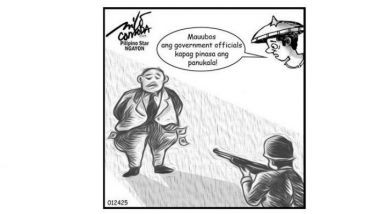Heritage Festival’s pride in RP culture / UNI honors achievers
April 22, 2006 | 12:00am
The Filipino Heritage Festival, Inc., an organization of dedicated, determined, highly nationalistic individuals headed by Bambi Harper, Festival director, and Armita Rufino, Festival president, is implementing President Arroyo’s Proclamation No. 439 on Aug. 11, 2003 "declaring May of every year National Heritage Month in recognition of the need to create among the people a consciousness, respect, and love for the legacies of Filipino cultural history."
Gratifyingly, the Heritage Festival’s cultural activities will take place not only in Manila but also in the provinces.
Spanish and American influences have resulted in a blend of the foreign and the native, yet Filipinos have fashioned out of these influences what is truly and intrinsically our own. Through the past three years, the FHFI has been promoting and preserving this, having delved into various sources that bring out and re-discover traditional practices, spectacles, products, sites which bring genuine pride and joy to all Filipinos.
Take the zarzuela. Out of the Spanish zarzuela, we have developed our own. The FHFI will present the Ilongo Ang Gugma ni Dansoy kag ni Rosing (The Love of Dansoy and Rosing), the Pinoy-style operetta at the RCBC Theater on May 11; Marikina on May 13; Makati on May 16; AFP Theater on May 18; CCP on May 21; Victorias, Occ. Negros on May 29. The zarzuela will be a revival of classic Ilongo songs and dances.
In the cast are James Norico as Dansoy and Mary Luz Casas as Rosing, Jeffrey Delmo, Hannamel Inventor, Kristine Barrera and Harley Villacampa. Taong-bayan are Christine Torpeno, Reyzille Galvez, Juanessa Galvez, Gerard Guanzon, Ritchie Espanola, Alex Alipoon and Mark Yamoyam. Dandansoy is directed by Aaron Sorbito and written by Salome Sorbito. Accompaniment is by the Neg. Occ. H.S. rondalla.
Decades ago, the zarzuela played a vital role in Philippine theater arts and literature. Ang Gugma has become the prototype for Filipino love and, generally, comedic stories.
Based on a true story from the early 1900s, when sugar was Negros’ prime commodity, Ang Gugma tells of star-crossed lovers Dansoy, a poor farm hand, and Rosing, daughter of the farm manager (encargado) – socially poles apart. Rosing’s parents forbid the couple’s relationship, deciding on sending their daughter to a convent. Dansoy, who reminds Rosing of their love for each other, is forced to let her go.
Pampangueños will see Ing Managpe (The Patcher), the first zarzuela in a Filipino language. Excerpts from local comedias and zarzuelas will likewise be shown.
Ing Managpe, an original one-act comedy about a domestic quarrel, was written by Mariano Proceso Byron of Bacolor, Pampanga, and premiered at its Teatro Sabina on Sept. 13, 1900.
In the comedy, Doña Juana threatens to leave her husband whom she suspects of infidelity. Worse, she discovers a woman’s handkerchief on the living room sofa, though Sianang, the housemaid, claims the handkerchief is hers. She then contends that the size of an object varies from small to large, depending on which end of the lens one looks through, Donna Juana, appeased by her maid’s counsel, decides to stay.
When Don Diego comes home, Sianang, not wishing to be discovered alone in the room with the houseboy Pablo, tells him to hide under the sofa. Sianang explains that the noises Don Diego hears are being made by the dog. Pablo’s sneeze reveals his hiding place. Doña Juana arrives to find her husband confronting the lovers. Don Diego reprimands his wife for her jealousy which, he claims, has caused her to neglect her duties in the home. Donna Juana apologizes for her suspicions and the couple reconcile.
Ing Managpe literally refers to the name of the dog, and symbolically, to the arbitrator who clears up the misunderstanding. Revolutionizing Philippine theater, Ing Managpe was the first play with a common domestic setting and everyday wear. Byron rid the zarzuela of its pretenses, relying on basic narrative and characterization to sustain audience interest.
The Center for Kapampangan Studies of Holy Angels U. will present the zarzuela on May 27 at its open-air stage. The cast will consist of faculty members and students; guest musicians from Bacolor, who reconstructed the play’s original melody, will provide the accompaniment.
Visits to heritage houses and churches will form part of FHFI’s extensive program. On May 6, Lakbay Bulacan will give glimpses of ancestral homes, centuries-old churches, the Biak-na-Bato National Park, the 400-year old Angat Church and Museum, and Pandi’s embroidery community.
The Museum Foundation will take visitors to Old Laguna on May 13, to ancestral homes in Pila, the Nineveh Contemporary Art Gallery in Sta. Cruz, Danny Dalena’s house in Pakil and Angelito Baldemor’s studio in Paete.
In Manila, on May 7, Sagalas will march from Rayah Sulayman Park to Bastion de San Diego in Intramuros under the auspices of Unilever and DOT. The sagalas’ baro’t saya will be designed by the Fashion Designers’ Association headed by Ben Farrales.
Many other aspects of Philippine culture will be presented by the FHFI as its own counterpart of French Spring, the Spanish Fiesta, the British and German months, etc.
Uni Writing Instruments, a leading brand of Lupel Marketing Corp. and Mitsubishi Pencil Co., will honor, on its 75th anniversary these achievers on May 4 at the Pen: Liza Alvarez, education (teacher); Rouchelle Briones, education (student); Ed Calma, architecture; Rolando Hortaleza, business; Sen. Richard Gordon, public service; Che-Che Lazaro, media; Mischka Lagot, junior achiever; Dr. Greg Pastorfide, medicine; Gerard Salonga, music; Carlo Tanseco (design).
Gratifyingly, the Heritage Festival’s cultural activities will take place not only in Manila but also in the provinces.
Spanish and American influences have resulted in a blend of the foreign and the native, yet Filipinos have fashioned out of these influences what is truly and intrinsically our own. Through the past three years, the FHFI has been promoting and preserving this, having delved into various sources that bring out and re-discover traditional practices, spectacles, products, sites which bring genuine pride and joy to all Filipinos.
Take the zarzuela. Out of the Spanish zarzuela, we have developed our own. The FHFI will present the Ilongo Ang Gugma ni Dansoy kag ni Rosing (The Love of Dansoy and Rosing), the Pinoy-style operetta at the RCBC Theater on May 11; Marikina on May 13; Makati on May 16; AFP Theater on May 18; CCP on May 21; Victorias, Occ. Negros on May 29. The zarzuela will be a revival of classic Ilongo songs and dances.
In the cast are James Norico as Dansoy and Mary Luz Casas as Rosing, Jeffrey Delmo, Hannamel Inventor, Kristine Barrera and Harley Villacampa. Taong-bayan are Christine Torpeno, Reyzille Galvez, Juanessa Galvez, Gerard Guanzon, Ritchie Espanola, Alex Alipoon and Mark Yamoyam. Dandansoy is directed by Aaron Sorbito and written by Salome Sorbito. Accompaniment is by the Neg. Occ. H.S. rondalla.
Decades ago, the zarzuela played a vital role in Philippine theater arts and literature. Ang Gugma has become the prototype for Filipino love and, generally, comedic stories.
Based on a true story from the early 1900s, when sugar was Negros’ prime commodity, Ang Gugma tells of star-crossed lovers Dansoy, a poor farm hand, and Rosing, daughter of the farm manager (encargado) – socially poles apart. Rosing’s parents forbid the couple’s relationship, deciding on sending their daughter to a convent. Dansoy, who reminds Rosing of their love for each other, is forced to let her go.
Pampangueños will see Ing Managpe (The Patcher), the first zarzuela in a Filipino language. Excerpts from local comedias and zarzuelas will likewise be shown.
Ing Managpe, an original one-act comedy about a domestic quarrel, was written by Mariano Proceso Byron of Bacolor, Pampanga, and premiered at its Teatro Sabina on Sept. 13, 1900.
In the comedy, Doña Juana threatens to leave her husband whom she suspects of infidelity. Worse, she discovers a woman’s handkerchief on the living room sofa, though Sianang, the housemaid, claims the handkerchief is hers. She then contends that the size of an object varies from small to large, depending on which end of the lens one looks through, Donna Juana, appeased by her maid’s counsel, decides to stay.
When Don Diego comes home, Sianang, not wishing to be discovered alone in the room with the houseboy Pablo, tells him to hide under the sofa. Sianang explains that the noises Don Diego hears are being made by the dog. Pablo’s sneeze reveals his hiding place. Doña Juana arrives to find her husband confronting the lovers. Don Diego reprimands his wife for her jealousy which, he claims, has caused her to neglect her duties in the home. Donna Juana apologizes for her suspicions and the couple reconcile.
Ing Managpe literally refers to the name of the dog, and symbolically, to the arbitrator who clears up the misunderstanding. Revolutionizing Philippine theater, Ing Managpe was the first play with a common domestic setting and everyday wear. Byron rid the zarzuela of its pretenses, relying on basic narrative and characterization to sustain audience interest.
The Center for Kapampangan Studies of Holy Angels U. will present the zarzuela on May 27 at its open-air stage. The cast will consist of faculty members and students; guest musicians from Bacolor, who reconstructed the play’s original melody, will provide the accompaniment.
Visits to heritage houses and churches will form part of FHFI’s extensive program. On May 6, Lakbay Bulacan will give glimpses of ancestral homes, centuries-old churches, the Biak-na-Bato National Park, the 400-year old Angat Church and Museum, and Pandi’s embroidery community.
The Museum Foundation will take visitors to Old Laguna on May 13, to ancestral homes in Pila, the Nineveh Contemporary Art Gallery in Sta. Cruz, Danny Dalena’s house in Pakil and Angelito Baldemor’s studio in Paete.
In Manila, on May 7, Sagalas will march from Rayah Sulayman Park to Bastion de San Diego in Intramuros under the auspices of Unilever and DOT. The sagalas’ baro’t saya will be designed by the Fashion Designers’ Association headed by Ben Farrales.
Many other aspects of Philippine culture will be presented by the FHFI as its own counterpart of French Spring, the Spanish Fiesta, the British and German months, etc.
BrandSpace Articles
<
>
- Latest
- Trending
Trending
Latest
Trending
Latest
Recommended

January 23, 2025 - 12:00am

























